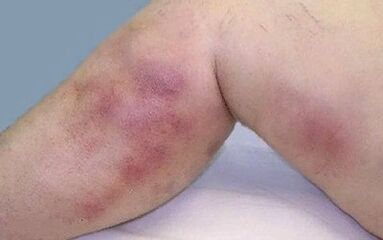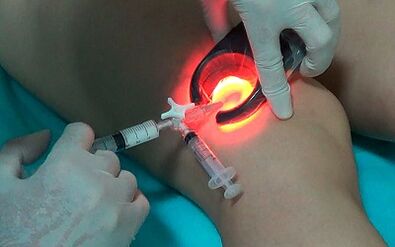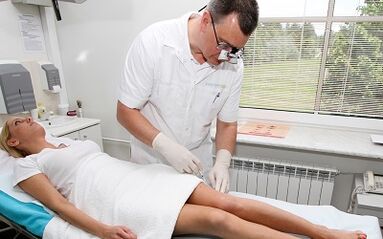Varicose veins are a fairly common disease, especially among women in which the work of the veins of the lower extremities is disrupted.This is due to the fact that venous valves suffer - these are a kind of shutter that regulate the reverse outflow of blood from the legs.Normally, the valves should be closed and open depending on the flow of blood.
With varicose veins, they almost do not close, due to which stagnation of blood develops in the veins of the lower extremities.Naturally, a large amount of accumulated blood in the veins leads to stretching their walls, a decrease in elasticity, and sometimes even damage.Accordingly, with the progression of the process, characteristic manifestations arise on the skin.
At first, these are just vascular nets, stars, then tubercles of blue and crimson -colored yarn appear, the legs become swollen, the skin begins to peel off, constant pains in the lower extremities are worried.Therefore, it is very important to recognize the disease at the initial stage and start treatment in time.
The causes of the development of the disease
Varicosis can develop under the influence of many factors from the outside.Of course, it all depends on the lifestyle of a person.However, there are a number of predisposing risk factors that increase the likelihood of varicose veins.
Such factors are a hereditary predisposition, impaired hormonal balance, disease of the nervous system, inactive lifestyle, physical overload, flat feet, wearing high -heeled shoes.
Hereditary predisposition.Unfortunately, if close relatives suffered from this disease, then there is a probability that it is transmitted to you, so often this is due to the hereditary weakness of the connective tissue or a defect in the vein valves.In this case, it is necessary to remember the prevention of varicose veins.
Hormonal imbalance.Constant fluctuations in the level of hormones are most inherent in women, and therefore, according to statistics, they are more susceptible to varicose veins.Similar fluctuations are observed throughout the menstrual cycle, during pregnancy and during menopause.The use of hormonal drugs (for example, contraceptives) also affects.Female hormones significantly affect the elasticity of the walls of blood vessels.
Diseases of the nervous system, frequent stresses, depressive conditions.It is known that it is the nervous system that regulates the venous tone.Therefore, any pathologies associated with it can affect the state of veins;
Inflammatory processes in the pelvis.They often bother the female floor.Because of them, the level of hormones can be significantly disturbed.
A sedentary lifestyle.Due to the long-term sitting at the computer, for example, the veins of the legs are squeezed out, the outflow of blood is disturbed from them.Due to the stagnation of blood, the vascular walls stretch and thin out.To date, even “computer varicose veins” are distinguished, so often it has become found.
Physical overload.Excessive physical activity also does not affect anything good on the vessels.Heavy lifting, constant walking increase the load on the feet and, accordingly, on the veins.
Flat feet.One way or another, this is a deformation of the foot, and it also carries a certain effect on the vessels of the lower extremities.
Constitution.Open people and especially with high growth are very prone to varicose veins in the future.
Wearing high heels-again, it is dangerous for women, since when walking on high and not particularly comfortable heels, the load on the lower limbs enhances tremendously.
Clinical manifestations of varicose veins
Symptoms of the disease appear gradually, but they progress steadily, especially in the absence of proper treatment.It all starts with the appearance of small vascular nets and stars on the legs, the so -called telangiectasias.They do not cause much discomfort, but already with these manifestations it is necessary to seek a doctor’s consultation.
In the future, swelling on the legs that appear after prolonged walking and most often in the evening begin to bother.By morning they pass on their own.This is the first signal that the function of deep veins that return blood to the heart is impaired.
Over time, patients begin to complain about convulsions in the legs, their numbness, in particular at night and in the morning.If the treatment was not started at these stages, then venous nodules will appear on the skin, the veins will be visible, bluish or even closer to the crimson color, they will be painful on palpation.The skin on the lower extremities will begin to gradually change.It will become dense to the touch, dry, will begin to peel off and darken.When walking, severe muscles will be disturbed.
In the places of the appearance of venous nodes, severe itching will be felt.Involuntary contractions of the calf muscles at night may also occur.
Diagnosis and complications of varicose veins

Diagnosis of the disease is necessary as early as possible.But it all depends on the patient to go to the hospital.
In diagnosis, they are based on complaints, external manifestations on the legs, the patient’s lifestyle, his bad habits, physique, the presence of varicose veins in parents, brothers, sisters.
To confirm the diagnosis, additional instrumental examination methods are prescribed.
Such methods are:
- Ultrasound examination of veins (ultrasound) - it is also known as dopplerography of the veins of the lower extremities.It allows you to evaluate the structure of the veins, their cross-country ability, speed and direction of blood flow, the presence of thrombotic formations, the expansion of blood vessels, the presence of any tumors.
- Contrast venography, or phlebography - it is carried out by introducing a contrast matter into the vessels.Its distribution shows the patency of the veins, the condition of the walls, the presence of volumetric formations in vascular gaps.
An ultrasound is considered more preferable, since this is a non -invasive research method.
In the absence of adequate treatment, varicose veins can turn into a number of complications.
These include:
- thrombophlebitis - inflammation of expanded and deformed veins;
- bleeding due to the rupture of thinned vascular walls;
- a change in the rheological properties of blood, which leads to the formation of blood clots, this, in turn, can lead to pulmonary artery thromboembolism, myocardial infarction and stroke;
- Excessive skin pigmentation.
Trophilic ulcers-they can appear from the slightest wound or damage to the skin due to a constantly impaired outflow of blood.As a result, ulcers do not heal for a very long time, they hurt terribly and smell unpleasantly.
All this significantly worsens the quality of life of patients and can even make them disabled.
Basic methods for the treatment of varicose veins

Unfortunately, varicose veins is a chronic disease, and there are no methods to completely cure it.However, medicine found funds to at least prevent the progression of the disease.
Treatment directly depends on the stage of varicose veins.If these are only initial manifestations, then you can do without surgical interventions, that is, only conservative methods.
Drugs - this includes drug tone (venotonics), anti -impoverished drugs to prevent blood clots, non -steroidal anti -inflammatory drugs (painkillers), angioprotectors, as well as all kinds of creams, ointments and gels for the skin of the legs.
Compression methods - they provide for the use of compression stockings, imposing dressings from elastic bandages to maintain tone.
A pneumatic massage is a special massage that is carried out using a pneumatic massager.This is very effective, as it improves blood circulation, tissue nutrition, and enhances the tone of blood vessels.
Sclerotherapy is already an extreme method.It is carried out without operating manipulations.For sclerosis, that is, subsidizing the vessel, a special substance is injected into it, which stops the blood flow in the vessel, as a result of which it is atrophied over time, does not function and disappears.However, several sclerotherapy sessions may be required to achieve the desired effect.
Intravascular laser coagulation is already an invasive treatment method.At the same time, with the help of a laser, surgeons coagulate damaged veins under local anesthesia.
Leeches are a slightly outdated method, but still effective.He belongs to folk medicine.When applying leeches, bite the skin and, when sucking, is released into the blood substance called girudin.It dilutes blood and does not allow blood clots.
Diet - in the diet of patients suffering from varicose veins, there should be a large number of vegetables and fruits in any form, seafood, legumes, nuts, low -fat varieties of meat and dairy products.
Among non -traditional methods of treatment, compresses from apple cider vinegar, soap and potatoes, soda lotions and baths, and the use of tincture from ginseng are given preference.
The basics of varicose prevention

Many people wonder if it is possible to cure varicose veins finally?The answer is not.However, certain preventive measures can be observed in order to prevent the occurrence of the disease.
In particular, this is an active lifestyle, getting rid of extra pounds, constant gymnastics for the lower extremities, the use of compression linen.
If the disease has already appeared, then the use of hormonal contraceptives must be avoided (they contain female hormones that can aggravate the course of the disease).
In addition, it should be avoided:
- The use of any shoes in heels, as this increases the load on the feet.
- Increase in body weight and, even more so, obesity.
- The presence in the diet of fat, sharp, fried, smoked and salty.
- Heavy lifting.
- Long lying in a hot bath.
- Visiting a bath and sauna.
- Abuse of alcohol, smoking.
- Self -medication without consulting a doctor.
In addition, those who have to be in a sitting or standing position for a long time should take into account that:
- During a long stay on the legs, it will not hurt to climb to the socks and drop to the heels, move to the foot and vigorously move your fingers to disperse the accumulated blood;
- With prolonged work in the office in front of the computer, you can periodically put your legs on the table, so that the blood will flow better from the legs;
- You can purchase a special knife stand on which it will be very convenient to do any gymnastics;
- It is very useful to periodically raise and lower the fingers, this tone the calf muscles and activates the blood flow in the veins.
Be sure to get up every hour, walk around for several minutes and do a small charge.

















